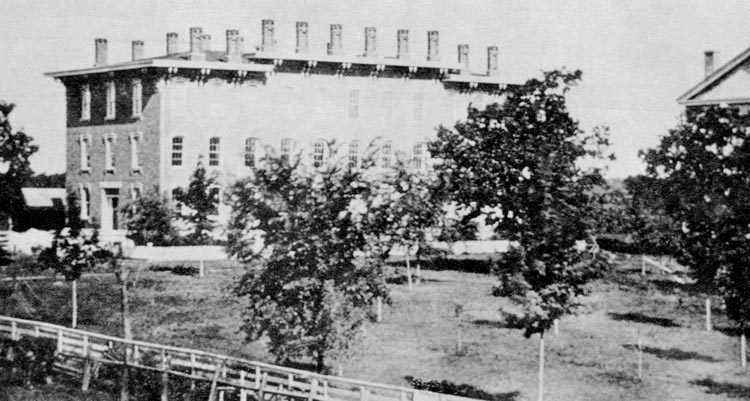
South Hall, completed adjacent to Old Cap (right) in 1862 as the university’s first dormitory, became first home to
the UI med school in 1870. The image, which includes a fence built to keep roaming livestock off Pentacrest,
was recorded about 1865 by noted pioneer photographer Isaac Wetherby.
|
By
Bob Hibbs A
body snatching from Iowa City’s Oakland Cemetery nearly caused the death of
the University of Iowa medical school in 1870, just months after its birth. The
gigantic modern-day impact of more than half a million visitors to Iowa City
annually was nearly wiped out three years before University Hospitals was
born. Annual U-Hospital revenues now top $700 million. The
incident involved the nighttime theft on Dec. 27, 1870, of an old woman’s
body from a new grave. The body was taken to a med school laboratory in the
South Hall basement immediately adjacent to Old Capitol. Instruction had begun
that fall with 37 students including eight women, and finger-pointing began
immediately. A
pocket notebook imprinted with “D Bradley” had been discovered at the
disturbed gravesite and the med school custodian was Dominick Bradley. Rumor
linked anatomy Prof. J. M. Boucher to the purchase of supplies used to
preserve laboratory specimens from a local druggist. Dr.
Boucher already had a dark reputation, including rumor of prison in another
state. As
talk circulated in the community of the sexton’s discovery of the dastardly
deed, the body was spirited out a west window of South Hall on Dec. 31, just
moments before angry townspeople began guarding Pentacrest to prevent just
such an event from occurring before the sheriff could search. At
that time the west half of Pentacrest was unkept scrub brush and timber
covering the steep bank down onto the river floodplain. Its principle use was
as a trash dump, including ashes from heating stoves in Old Capitol and its
two companion halls. One could disappear quickly on horseback into the mists
of the moors. The
sheriff searched the next morning – on New Year’s Day 1871 – but found
only a heavily-dissected male cadaver which reportedly deserved the name
“Moses” given it by frustrated students. Two
med students had hauled the woman’s body away on horseback to a site near
today’s West High School and hid it in a haystack from which it later was
retrieved and reburied in the Rose Hill section of the cemetery. Evidence
resulted in brief arrests, but no one was formally charged. Prominent
local newspaper publisher John Irish, a former university trustee and promoter
of the medical school, sought a truce. From his Clinton House office on the
southeast corner of the Clinton-College intersection, he secured agreement
from the deceased’s family and from authorities that if the body was
returned, no charges would result. Irish,
who in 1866 had succeeded in obtaining the first state appropriation for UI,
asked an undertaker to place an unattended coffin in an alley behind his
funeral home. At Irish’s request, the body was returned by parties unknown.
Examination revealed dissection cuts, but the coffin was closed and the body
reburied Jan. 2, 1871. During
an unsuccessful gubernatorial bid a decade later, Republicans associated Irish
throughout the state with the “grave snatching” story. Dr. Boucher had
resigned, citing “the pressure of a private practice,” and moved to
California. Bradley left, too. By
1872 medical enrollment had reached 71. Surgery was performed in South Hall
and patients sent to nearby boarding houses to recover. Of course, many
didn’t. The
following year a hospital was opened in the Mechanics Academy building two
blocks east of Pentacrest where the university itself had been first opened in
1855. Dr.
Boucher’s legacy turns out to have been his letter written prior to the
graveyard incident to Iowa Gov. Samuel Merrill asking that unclaimed bodies at
the state penitentiary be given to the university. The
next legislature approved, providing early teaching specimens far superior to
dogs and cats, which had been disappearing frequently from Iowa City streets.
All in the interest of science, of course. Next
Saturday: Horse burials at Kinnick
Stadium. Bob Hibbs collects local postcards and other historic ephemera and researches history related to them. |